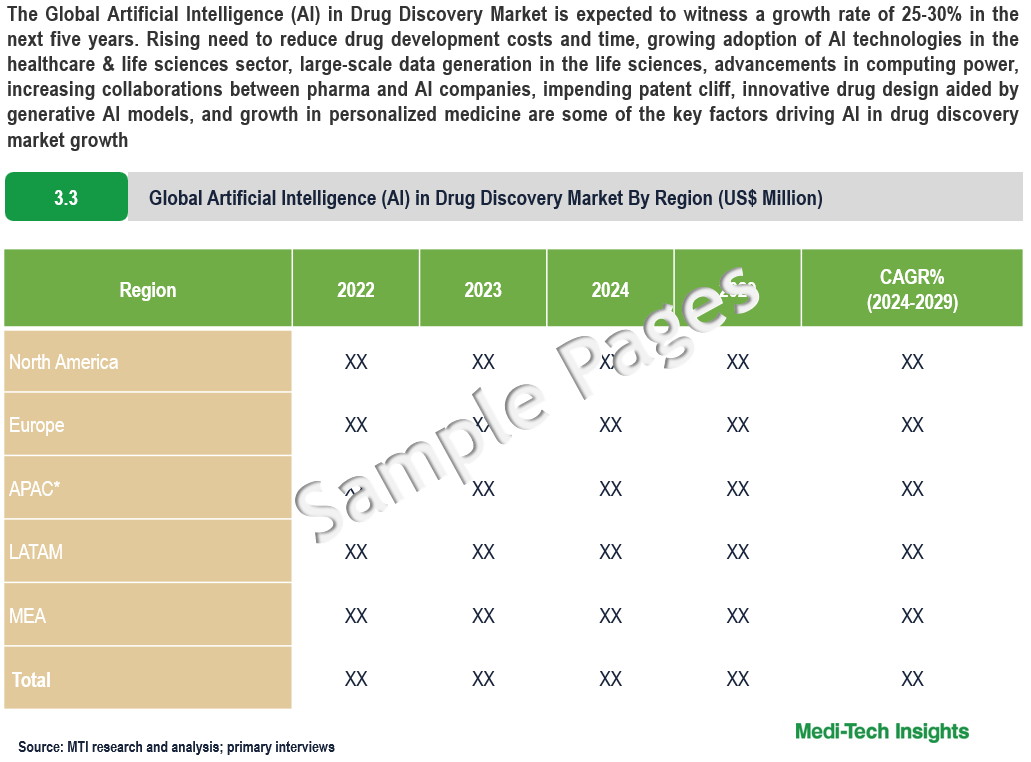
Global Artificial Intelligence (AI) in Drug Discovery Market Size, Share, Trends, Demand & Growth Analysis 2024 to 2029
The Global Artificial Intelligence (AI) in Drug Discovery Market is expected to witness a growth rate of 25-30% in the next five years. Rising need to reduce drug development costs and time, growing adoption of AI technologies in the healthcare & life sciences sector, large-scale data generation in the life sciences, advancements in computing power, increasing collaborations between pharma and AI companies, impending patent cliff, innovative drug design aided by generative AI models, and growth in personalized medicine are some of the key factors driving AI in drug discovery market growth. However, high implementation costs, data privacy and security concerns, lack of quality and standardized data, and regulatory and ethical issues are likely to hinder the market growth. To learn more about the research report, download a sample report.
Artificial Intelligence (AI) in drug discovery refers to the application of advanced computational techniques to enhance the efficiency and accuracy of identifying and developing new pharmaceuticals. AI methods, like machine learning (ML) and deep learning (DL), enable the analysis of vast chemical spaces, predicting molecular properties, optimizing drug designs, and facilitating drug repurposing. This integration significantly accelerates the drug development process while reducing costs and improving success rates in bringing new therapies to market.
Rising Need to Reduce Drug Development Costs and Time to Drive Market Growth
The rising need to reduce drug development costs and time is a key driver for the growth of the AI in drug discovery market. Traditional drug development is a lengthy and costly process. Drug discovery has become an increasingly expensive, risky, and time-consuming process, with estimates suggesting it costs around USD 2.5 billion to bring a new drug to market, factoring in the costs of failures. Scientific and technical challenges contribute to the low probability of discovering a new drug and advancing it to clinical trials, which stands at roughly 35%. Furthermore, the chances of successfully progressing a candidate from Phase 1 trials to regulatory approval are only 9-14%. Overall, this process typically takes an average of 12-15 years. AI technologies offer solutions to these challenges by streamlining and accelerating various stages of drug development. For instance, AI algorithms can analyse large datasets, predict potential drug candidates, and optimize chemical properties, significantly reducing early-stage research time. Additionally, AI can assist in identifying promising drug compounds more efficiently, which can lower research costs. AI-driven virtual screening has also been shown to significantly cut lead time for potential drug candidates. Consequently, pharmaceutical companies are increasingly adopting AI to minimize research expenses and shorten development timelines, ultimately driving market growth as they seek to enhance productivity and profitability in a competitive landscape.
“The attrition rate during clinical trials is approximately 90%, meaning that only a small fraction of drugs that enter clinical development ultimately receive approval. This high failure rate contributes significantly to the overall costs of drug development"- Associate Director, A Leading AI in Drug Discovery Company, United States
Advancements in Computing power to Fuel Market Growth
Advancements in computing power are significantly driving the growth of the AI in drug discovery market. High-performance computing (HPC) and the development of powerful GPUs and TPUs have enabled AI algorithms to process massive datasets, perform complex calculations, and model intricate biological processes more efficiently. Enhanced computing power allows researchers to simulate drug interactions, predict molecular behavior, and identify potential drug candidates at an accelerated pace. This capability leads to a reduction in drug development timelines and costs, traditionally a lengthy and expensive process. Machine learning models, powered by advanced computing, can analyse vast genomic, proteomic, and chemical libraries, uncovering new insights that are often missed by conventional methods. Moreover, the integration of quantum computing promises to further revolutionize this space, allowing the simulation of complex molecular structures and interactions with unprecedented accuracy. These advancements also facilitate the adoption of AI-driven personalized medicine, where treatments can be tailored based on a patient's unique genetic makeup. As computing power continues to grow, AI systems will become even more effective, thereby attracting more investments and accelerating innovation in the drug discovery market. This, in turn, will fuel the market’s expansion and potentially lead to more effective and affordable therapeutics.
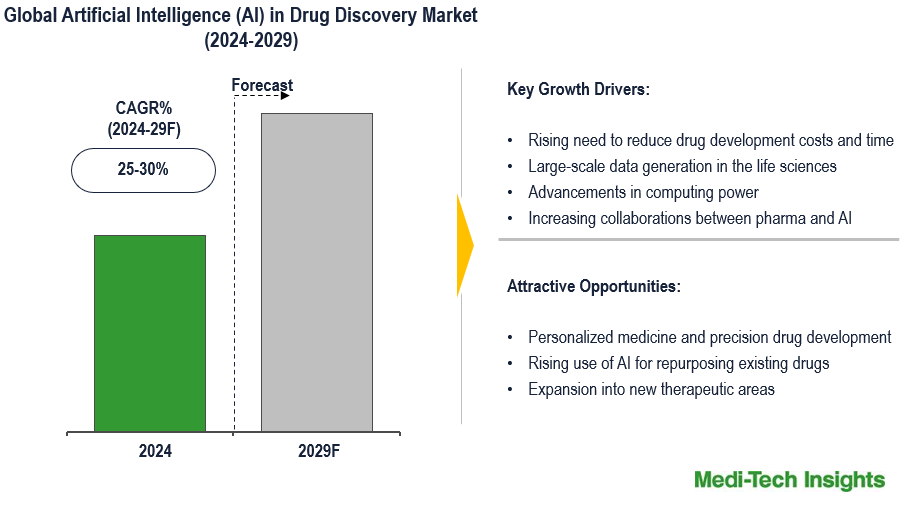
To learn more about this report, download the PDF brochure
Continued Trend of Increasing Collaborations Between Pharma and AI Companies
The AI in drug discovery market is experiencing rapid growth, largely fuelled by the increasing trend of collaborations between pharmaceutical companies and AI-focused firms. Traditional drug development is costly and time-consuming, pushing pharmaceutical companies to seek innovative solutions to enhance efficiency and reduce costs. AI companies provide the advanced algorithms, machine learning models, and data analytics tools needed to streamline various phases of drug discovery, from target identification to clinical trials. Pharma companies partner with AI firms to leverage their expertise in handling vast datasets, including genomic, proteomic, and clinical data. These collaborations enable more accurate predictions of drug candidates’ effectiveness, toxicity, and potential side effects. For AI companies, these partnerships offer access to valuable pharmaceutical data, research funding, and the ability to apply their technologies in real-world settings. Such collaborations have led to several successful outcomes, including the identification of new drug candidates, drug repurposing efforts, and optimization of clinical trial designs. Strategic partnerships, joint ventures, and licensing agreements between pharma and AI companies are becoming common, propelling market growth. This trend is expected to continue as both sectors recognize the synergistic benefits, driving innovation and accelerating the drug discovery process, ultimately leading to faster and more effective therapeutic solutions.
North America Expected to be a Major Growth Engine in the AI in Drug Discovery Market
North America is poised to be a major growth engine in the AI in drug discovery market due to several key factors. The region hosts a robust pharmaceutical industry, with many leading companies actively investing in AI to streamline drug development and reduce costs. The presence of advanced healthcare infrastructure, abundant research institutions, and significant government and private funding further facilitates the adoption of AI technologies in drug discovery. Moreover, North America is home to numerous AI and biotechnology start-ups, which are increasingly collaborating with pharmaceutical giants to develop AI-driven solutions. Supportive regulatory frameworks, such as the USFDA’s initiatives for AI in healthcare, provide a conducive environment for innovation and faster drug development. The vast amount of healthcare data generated in the region, combined with advancements in data analytics and computing power, makes North America a hotbed for AI applications in drug discovery. With these factors, North America is expected to drive market growth, attracting investments and pioneering new AI-driven drug discovery techniques. The Growth in APAC is driven by expanding pharmaceutical industry, increasing investments in healthcare infrastructure, a growing focus on precision medicine, and supportive government initiatives promoting AI research and development. Additionally, the rising prevalence of chronic diseases boosts demand for innovative drug discovery methods.
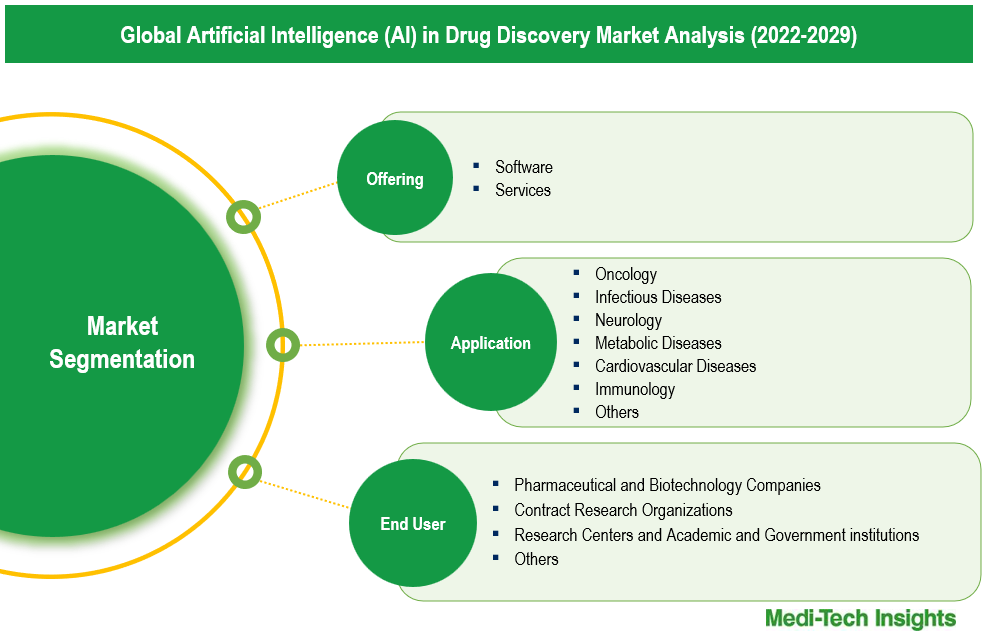
To learn more about this report, download the PDF brochure
Offering Type Segment Analysis
The AI in drug discovery market comprises of offering types like: Software and Services. the drug discovery software segment holds the largest market share. This dominance is due to the increasing adoption of AI-based software platforms for data analysis, drug design, target identification, and predictive modeling. AI software solutions streamline the drug discovery process, enhancing accuracy and reducing development time. On the other hand, the services segment is the fastest-growing. The surge in demand for AI services, such as consulting, integration, and support, is driving this growth. Pharmaceutical companies and research institutions increasingly seek customized AI solutions, requiring expert services to implement and manage these technologies effectively. Additionally, the complexity of AI software deployment and the need for ongoing maintenance and optimization fuel the rapid expansion of the services segment.
Application Type Segment Analysis
The AI in drug discovery market can be analyzed based on application types, such as Oncology, Infectious Diseases, Neurology, Metabolic Diseases, Cardiovascular Diseases, Immunology and Others. oncology is the largest segment. The high prevalence of cancer, coupled with the complexity of its treatment, drives the adoption of AI to identify novel drug candidates, understand disease mechanisms, and enhance precision medicine approaches. The vast amount of data generated in cancer research also necessitates AI tools for effective analysis. Infectious diseases segment is expected to show a significant growth over the forecast period. The recent global focus on combating infectious diseases, particularly in the wake of the COVID-19 pandemic, has accelerated the adoption of AI. AI's ability to rapidly identify drug targets, predict disease spread, and facilitate vaccine development has led to its growing use in this area. Additionally, the need for quick and cost-effective drug discovery for emerging pathogens contributes to the rapid growth of the infectious diseases segment.
Organic and Inorganic Growth Strategies Adopted by Players to Establish Their Foothold in the Market
Players operating in this market are adopting both organic and inorganic growth strategies such as collaborations, acquisitions, and new product launches to garner market share. For instance,
- In July 2024, Exscientia launched an AI-powered drug discovery platform using Amazon Web Services (AWS) to integrate generative AI and robotic lab automation, aiming to accelerate drug development at a lower cost. The platform enhances the drug design, synthesis, and testing process to deliver high-quality drug candidates efficiently
- In May 2024, Google DeepMind launched AlphaFold 3, an AI model designed to enhance drug discovery by mapping the behavior of all molecules, including human DNA. The new version aims to reduce development time and costs, offering a free online server to make complex biological testing easier for researchers
- In May 2024, Sanofi partnered with Formation Bio and OpenAI to leverage AI for faster drug development, combining data, software, and customized AI models. This collaboration aims to streamline the drug development lifecycle, with Sanofi offering extensive data and OpenAI providing deep AI expertise
- In February 2024, Almirall partnered with Microsoft to accelerate drug discovery in dermatology using AI and advanced analytics. This three-year collaboration aims to leverage generative AI and data management to develop innovative treatments and optimize Almirall's digital transformation
- In September 2023, Merck entered into a strategic collaboration with BenevolentAI and Exscientia to harness AI-driven drug design and discovery in oncology, neurology, and immunology. These partnerships aim to accelerate the development of novel clinical drug candidates, enhancing Merck's R&D productivity and pipeline
The AI in drug discovery market is expected to gain further momentum in the coming years due to technological advancements, rising R&D investments, and aggressive organic and inorganic growth strategies followed by the players.
Competitive Landscape Analysis
The global AI in Drug Discovery market is marked by the presence of established market players such as Atomwise Inc., BenchSci, BenevolentAI, BPGbio, Inc., Deep Genomics, Exscientia, Google, Iktos, Illumina, Inc., IBM Corporation, Insilico Medicine, Insitro, Microsoft Corporation, Nvidia Corporation, Numedii, Inc., Recursion, Schrödinger, Inc., Tempus Labs, Valo Health, Verge Genomics, and Xtalpi Inc. among others.
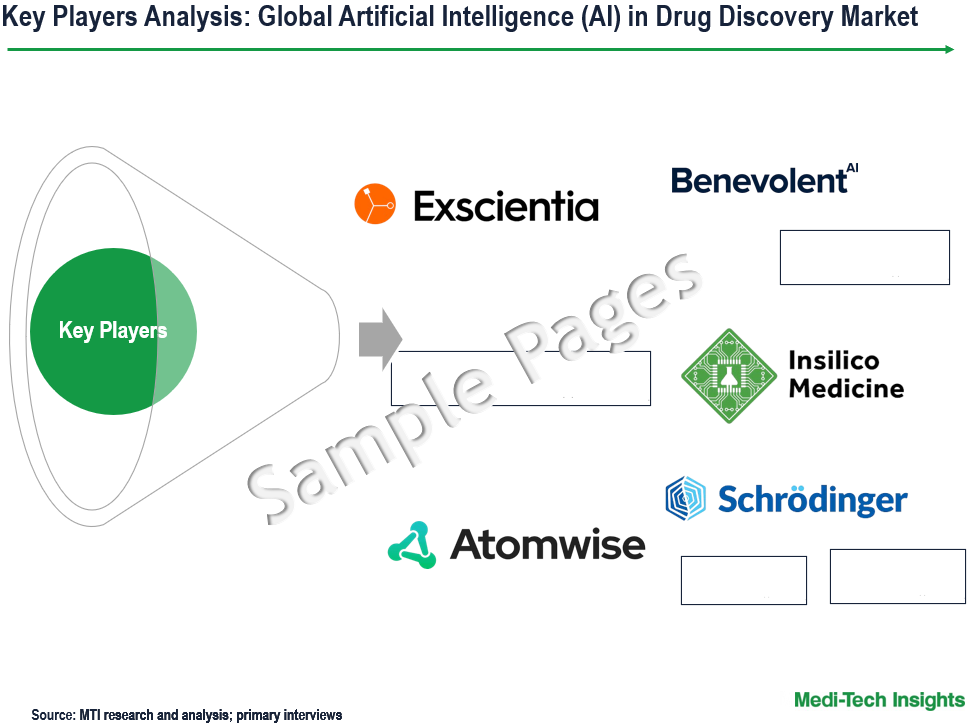
Get a sample report for competitive landscape analysis
Future Outlook of the AI in Drug Discovery Market
The global AI in drug discovery market is expected to gain further momentum in the coming years due to the rising demand for efficient drug discovery, increasing volume of biomedical data, advancements in AI and machine learning and growing investment and funding. These factors collectively contribute to the growth and evolution of the AI in drug discovery market.
AI in Drug Discovery Market Scope
|
Report Scope |
Details |
|
Base Year Considered |
2023 |
|
Historical Data |
2022 - 2023 |
|
Forecast Period |
2024 - 2029 |
|
Growth Rate |
25-30% |
|
Segment Scope |
Product, Application, End User |
|
Regional Scope |
|
|
Key Companies Mapped |
Atomwise Inc., BenchSci, BenevolentAI, BPGbio, Inc., Deep Genomics, Exscientia, Google, Iktos, Illumina, Inc., IBM Corporation, Insilico Medicine, Insitro, Microsoft Corporation, Nvidia Corporation, Numedii, Inc., Recursion, Schrödinger, Inc., Tempus Labs, Valo Health, Verge Genomics, and Xtalpi Inc. among others |
|
Report Highlights |
Market Size & Forecast, Growth Drivers & Restraints, Trends, Competitive Analysis |
Key Strategic Questions Addressed
-
What is the market size & forecast for the Global AI in Drug Discovery Market?
-
What are the historical, present, and forecasted market shares and growth rates of various segments and sub-segments of the Global AI in Drug Discovery Market?
-
How has COVID-19 impacted the Global AI in Drug Discovery Market?
-
What are the major growth drivers, restraints/challenges impacting the market?
-
What are the opportunities prevailing in the market?
-
What is the investment landscape?
-
Which region has the highest share in the global market? Which region is expected to witness the highest growth rate in the next 5 years?
-
Who are the major players operating in the market? What is the competitive positioning of key players?
-
Who are the new players entering the market?
-
What are the key strategies adopted by players?
- Introduction
- Introduction
- Market Scope
- Market Definition
- Segments Covered
- Regional Segmentation
- Research Timeframe
- Currency Considered
- Study Limitations
- Stakeholders
- List of Abbreviations
- Key Conferences and Events (2023-2024)
- Research Methodology
- Secondary Research
- Primary Research
- Market Estimation
- Bottom-Up Approach
- Top-Down Approach
- Market Forecasting
- Executive Summary
- Artificial Intelligence (AI) in Drug Discovery Market Snapshot (2023-2029)
- Segment Overview
- Regional Snapshot
- Competitive Insights
- Market Overview
- Market Dynamics
- Drivers
- Rising need to reduce drug development costs and time
- Growing adoption of AI technologies in the healthcare & life sciences sector
- Large-scale data generation in the life sciences
- Advancements in computing power
- Impending patent cliff
- Innovative drug design aided by generative AI models
- Restraints
- High implementation costs
- Data privacy and security concerns
- Lack of quality and standardized data
- Regulatory and ethical issues
- Opportunities
- Personalized medicine and precision drug development
- Rising use of AI for repurposing existing drugs
- Expansion into new therapeutic areas
- Key Market Trends
- Increasing collaborations between pharma and AI companies
- Integration of omics data
- Increased Investment and Funding
- Unmet Market Needs
- Industry Speaks
- Regulatory Analysis
- Drivers
- Market Dynamics
- Global Artificial Intelligence (AI) in Drug Discovery Market Size & Forecast (2022-2029), By Product Type, USD Million
- Introduction
- Software
- Services
- Global Artificial Intelligence (AI) in Drug Discovery Market Size & Forecast (2022-2029), By Application Type, USD Million
- Introduction
- Oncology
- Infectious Diseases
- Neurology
- Metabolic Diseases
- Cardiovascular Diseases
- Immunology
- Others
- Global Artificial Intelligence (AI) in Drug Discovery Market Size & Forecast (2022-2029), By Process, USD Million
- Introduction
- Target Identification & Selection
- Target Validation
- Hit Identification/Characterization & Prioritization
- Hit-to-lead Identification/ Lead generation
- Lead Optimization
- Biomarker Discovery
- Candidate Selection & Validation
- Others
- Artificial Intelligence (AI) in Drug Discovery Market Size & Forecast (2022-2029), By End User, USD Million
- Introduction
- Pharmaceutical and Biotechnology Companies
- Contract Research Organizations
- Research Centres and Academic and Government institutions
- Others
- Global Artificial Intelligence (AI) in Drug Discovery Market Size & Forecast (2022-2029), By Region, USD Million
- Introduction
- North America Artificial Intelligence (AI) in Drug Discovery Market Size & Forecast (2022-2029), By Country, USD Million
- US
- Market Size & Forecast, By Product Type (USD Million)
- Market Size & Forecast, By Application Type (USD Million)
- Market Size & Forecast, By Process (USD Million)
- Market Size & Forecast, By End User (USD Million)
- Canada
- Market Size & Forecast, By Product Type (USD Million)
- Market Size & Forecast, By Application Type (USD Million)
- Market Size & Forecast, By Process (USD Million)
- Market Size & Forecast, By End User (USD Million)
- Europe Artificial Intelligence (AI) in Drug Discovery Market Size & Forecast (2022-2029), By Country, USD Million
- UK
- Market Size & Forecast, By Product Type (USD Million)
- Market Size & Forecast, By Application Type (USD Million)
- Market Size & Forecast, By Process (USD Million)
- Market Size & Forecast, By End User (USD Million)
- Germany
- Market Size & Forecast, By Product Type (USD Million)
- Market Size & Forecast, By Application Type (USD Million)
- Market Size & Forecast, By Process (USD Million)
- Market Size & Forecast, By End User (USD Million)
- France
- Market Size & Forecast, By Product Type (USD Million)
- Market Size & Forecast, By Application Type (USD Million)
- Market Size & Forecast, By Process (USD Million)
- Market Size & Forecast, By End User (USD Million)
- Italy
- Market Size & Forecast, By Product Type (USD Million)
- Market Size & Forecast, By Application Type (USD Million)
- Market Size & Forecast, By Process (USD Million)
- Market Size & Forecast, By End User (USD Million)
- Spain
- Market Size & Forecast, By Product Type (USD Million)
- Market Size & Forecast, By Application Type (USD Million)
- Market Size & Forecast, By Process (USD Million)
- Market Size & Forecast, By End User (USD Million)
- Rest of Europe
- Market Size & Forecast, By Product Type (USD Million)
- Market Size & Forecast, By Application Type (USD Million)
- Market Size & Forecast, By Process (USD Million)
- Market Size & Forecast, By End User (USD Million)
- Asia Pacific (APAC) Artificial Intelligence (AI) in Drug Discovery Market Size & Forecast (2022-2029), By Country, USD Million
- China
- Market Size & Forecast, By Product Type (USD Million)
- Market Size & Forecast, By Application Type (USD Million)
- Market Size & Forecast, By Process (USD Million)
- Market Size & Forecast, By End User (USD Million)
- Japan
- Market Size & Forecast, By Product Type (USD Million)
- Market Size & Forecast, By Application Type (USD Million)
- Market Size & Forecast, By Process (USD Million)
- Market Size & Forecast, By End User (USD Million)
- India
- Market Size & Forecast, By Product Type (USD Million)
- Market Size & Forecast, By Application Type (USD Million)
- Market Size & Forecast, By Process (USD Million)
- Market Size & Forecast, By End User (USD Million)
- Rest of Asia Pacific
- Market Size & Forecast, By Product Type (USD Million)
- Market Size & Forecast, By Application Type (USD Million)
- Market Size & Forecast, By Process (USD Million)
- Market Size & Forecast, By End User (USD Million)
- Latin America (LATAM) Artificial Intelligence (AI) in Drug Discovery Market Size & Forecast (2022-2029), USD Million
- Market Size & Forecast, By Product Type (USD Million)
- Market Size & Forecast, By Application Type (USD Million)
- Market Size & Forecast, By Process (USD Million)
- Market Size & Forecast, By End User (USD Million)
- Middle East & Africa (MEA) Artificial Intelligence (AI) in Drug Discovery Market Size & Forecast (2022-2029), USD Million
- Market Size & Forecast, By Product Type (USD Million)
- Market Size & Forecast, By Application Type (USD Million)
- Market Size & Forecast, By Process (USD Million)
- Market Size & Forecast, By End User (USD Million)
- China
- UK
- US
- Competitive Landscape
- Key Players and their Competitive Positioning
- Competitive Positioning of Key Players (2022)
- Offerings Assessment, By Player
- Key Strategies Assessment, By Player (2021-2023)
- New Product & Service Launches
- Partnerships, Agreements, & Collaborations
- Mergers & Acquisitions
- Geographic Expansion
- Key Players and their Competitive Positioning
- Company Profiles*
(Business Overview, Financial Performance**, Products Offered, Recent Developments)
- Atomwise Inc.
- BenevolentAI
- Exscientia
- IBM Corporation
- Insilico Medicine
- Microsoft Corporation
- Nvidia Corporation
- Recursion
- Schrödinger, Inc.
- Other Prominent Players
The study has been compiled based on extensive primary and secondary research.
Secondary Research (Indicative List)
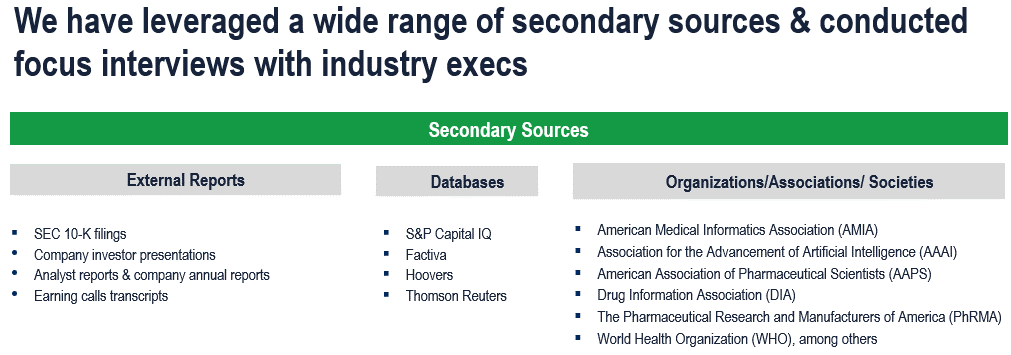
Primary Research
To validate research findings (market size & forecasts, market segmentation, market dynamics, competitive landscape, key industry trends, etc.), extensive primary interviews were conducted with both supply and demand-side stakeholders.
Supply Side Stakeholders:
- Senior Management Level: CEOs, Presidents, Vice-Presidents, Directors, Chief Technology Officers, Chief Commercial Officers
- Mid-Management Level: Product Managers, Sales Managers, Brand Managers, Business Development Managers, Consultants
Demand Side Stakeholders:
- Stakeholders in Pharmaceutical and Biotechnology Companies, Contract Research Organizations and Other End Users
Breakdown of Primary Interviews
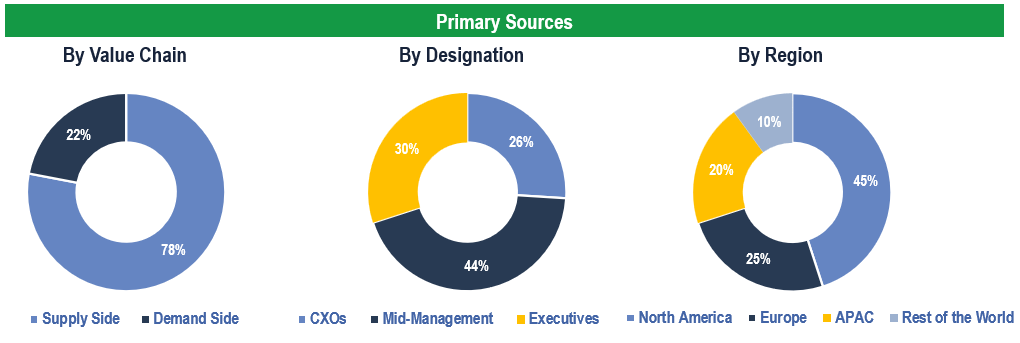
Market Size Estimation
Both ‘Top-Down and Bottom-Up Approaches’ were used to derive market size estimates and forecasts.
Data Triangulation
Research findings derived through secondary sources & internal analysis were validated with Primary Interviews, Internal Knowledge Repository, and Company Sales Data.

